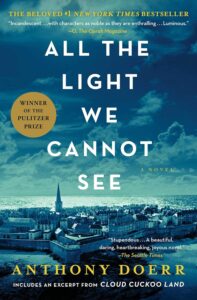I usually avoid reading fiction or watching movies starring characters who are blind. Too many writers and filmmakers portray blind characters one-dimensionally — we’re either heroic or tragic, bumbling or, particularly lately, blessed with super-powers.
But Netflix is releasing a limited series of four episodes of the film All the Light We Cannot Seetomorrow, November 2, and I am eager check it out.
The film is based on Anthony Doerr’s Pulitzer-Prize winning bestseller. I listened to the audio version when it came out in 2014, and if you ask me, he deserved that Pulitzer!
One of the main characters in Doerr’s novel All the Light We Cannot See is blind, but there’s much more to Marie-Laure LeBlanc than that. She grew up in Paris, her father is raising her on his own, and the two of them evacuate to a village in Brittany called St. Malo after Paris is invaded by the Nazis. Her father goes missing, and she’s a teenager by the time the Americans arrive on D-Day.
Written in third-person, Doerr’s chapters are very short — they swing back and forth between the changes young Marie-Laure is enduring in France and those that Werner Pfennig, an orphaned teenager in Germany, faces when placed in an elite Nazi training school there during WWII. The author avoids using visual descriptions in the chapters about Marie-Laure, since they are written from her point of view. So here’s a question for you blog readers who’ve read the book already: I bet you can describe Marie-Laure’s beloved Papa , but any idea what he looks like? Probably not, because the author never tells us that. There is little, if any, visual description of Étienne or Madame Manec (the pair Marie-Laure and her Papa live with in exile) either, yet readers come to know these characters very well, too. Here’s an example from early in the book, before Marie-Laure’s cigarette-smoking Papa goes missing:
Every time she comes within earshot, Marie-Laure hears the “Pfsssst!” of her father lighting another match. His hands flutter between his pockets.
Afternoons he repairs things around Étienne’s house: a loose cabinet door, a squeaking stair board. He asks Madame Manec about the reliability of the neighbors. He flips the locking clasp on his toolcase over and over, until Marie-Laure begs him to stop.
Marie-Laure doesn’t have to be able to see her Papa to know he is anxious, and neither do we. If Marie-Laure could see, the author wouldn’t have pointed out that she sees the cabinet door he is fixing, he would have just said “he’s fixing a cabinet door.” And so, he doesn’t use extra words to point out Marie-Laure hears the squeaky cabinet door, either. We know he’s fixing the cabinet door the same way Marie-Laure would know, and that helps us stay right in her head and experience her life during WWII the way she is.
As I continued reading, I noticed how often Doerr chose the verb “find” rather than describing Mari-Laure “feeling through” something or “”touching” an object. Sounds simple, I guess, but to me, keeping it simple like this is brilliant. Over and over again, the author resists the temptation to sound trumpets to remind the reader that Marie-Laure can’t see, and that keeps readers in the moment. Here’s another example, this one from later in the book when Marie Laure is alone and escaping into the attic:
Only thing to do is climb. Seven runs up into the long triangular tunnel of the garret. The raw timbered ceiling rises on both sides toward the peak, just higher than the top of her head.
Heat has lodged itself up here. No window. No exit. No where else to run. No way out, except the way she has come.
The passage continues:
Her outstretched fingers find an old shaving bowl, an umbrella stand, and a crate full of who-knows-what. The attic floor boards beneath her feet are as wide across as her hands. She knows from experience how much noise a person walking on them makes.
Isn’t it something, the way that using senses beyond the visual can make writing more colorful? Aria Mia Loberti, who is blind due to a severe form of the genetic condition achromatopsia, plays Marie-Laure Leblanc in the Netflix adaptation, which also stars Louis Hofmann, Hugh Laurie, and Mark Ruffalo. I’m hoping to start streaming it tomorrow – stay tuned!

Now you have me excited to see this too. I loved the book when it came out and have just remembered that I was going to read 20,000 Leagues Under the Sea after I finished this. Never did, oops.
Lovely description of his writing, Beth. I’m sending this off to my book club now…I think it was our first book.
Wow, If All the Light You Cannot See was your book club’s first book, you had an excellent start! Now let’s see how the movie is….
Me too! Thanks for the reminder,
I loved this novel and look forward to the miniseries. Thanks for your unique perspective on Doerr’s writing. I’d highly recommend reading his latest masterpiece Cloud Cuckoo Land if you haven’t yet read it.
Wow! Sounds like a great book and movie. Thank you for the great book review, Beth. Looking forward to seeing the series, hope it does the book justice.
One of my favorite book club reads.
excellent book, looking forward to seeing the movie
I read the book when it came out and I loved it! But you, Beth, pointed details of Marie-Laure interaction with the world around her that escaped me. Thank you! Few books had impressed me more like this one. Your observations are spot-on!
I just added this to my To Be Read (or the acronym TBD). With the review comments here, it is a must!
Leave a Response